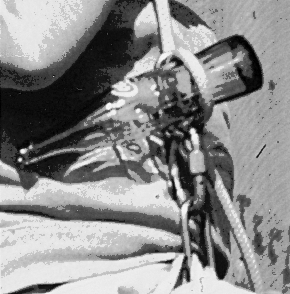Technical Details
I acquired my Coca-Cola® bottle from Steven D. Chattin, 2025.
The Coca-Cola bottle is 247 mm. tall, 61 mm. wide, and 61 mm. thick, and weighs 430 g.
I don't think glass is a good material for making descenders. While it is hard and will resist abrasion, glass lacks the strength and thermal conductivity of metal. Brittleness makes glass subject to shattering if struck during rappel. This only occurs during the user's final descent.
|
 |
Warning:
Don't ever rappel on a Coca-Cola Bottle,
no matter whether it is glass or plastic. |
 |
|
 Descenders come in many shapes and sizes, and many things not originally designed as descenders have been used over the years. Long ago, I think in the late 1960s/early 1970s, George Corrie saw the rapid changes occurring in vertical technology and realized “We don’t need no stinkin’ rappel racks.” To demonstrate, he showed how to rappel using a glass Coca-Cola® bottle. Ed Strausser sent me a phtot of the famous event, writing
Descenders come in many shapes and sizes, and many things not originally designed as descenders have been used over the years. Long ago, I think in the late 1960s/early 1970s, George Corrie saw the rapid changes occurring in vertical technology and realized “We don’t need no stinkin’ rappel racks.” To demonstrate, he showed how to rappel using a glass Coca-Cola® bottle. Ed Strausser sent me a phtot of the famous event, writing
The print is from the estate of George Bruce Corrie III. The photographer is not indicated. The picture is George Corrie rappelling at Dick Blenz' barn in Indiana.
I think the photo was published but I am still trying to find out where. I do not have permission to publish the one that Ed sent to me, but I've clipped, decolored, and posterized a small porion to show how George rigged the bottle.
Notice how the wasp-waist on the proprietary Coca-Cola bottle helps keep the bottle from slipping out from under the bight in the descent line. Straight-sided bottles don't have this "safety" feature.

For far more content, use a larger monitor and a full-width window.
Hundreds of cell phone users complained and asked me to for a simpler, mobile friendly site. In particular, they wanted me to limit each page to a small number of pictures and minimize my use of text. This new site provides what they asked for.

